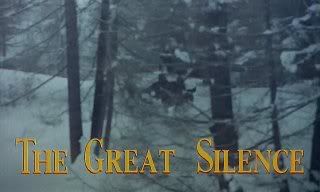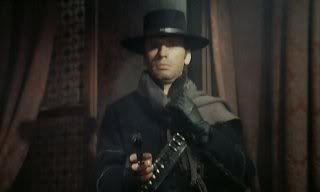
PLOT:
A young boy watches, powerless, as his parents are murdered by bounty hunters. The leader of the killers, Pollicutt--perhaps unable to kill a child--slits the boy’s throat, severing his vocal chords, so he’ll never tell the tale. That boy grows up to become a bounty hunter himself. Known only as “Silence” (guess why), he specializes in tracking down those bounty hunters who subvert the law and kill innocents in the name of justice, cashing in on their illicit and immoral behaviour. Silence’s main trick is to lure his opponents into drawing first, so he can gun them down with his Mauser in “self defence,” (ironically) subverting the law in the process.
Sergio Corbucci’s The Great Silence takes place in the fictional town of Snow Hill, Utah, during the great blizzard of 1899. There, due to the unseasonable weather, the starving townsfolk have had to fall into banditry to survive (though this isn’t very well explained). A general amnesty is expected from the governor, but until then Pollicutt, Snow Hill’s Justice of the Peace, is paying $1000 a head for these outlaws. This offer attracts to Snow Hill large groups of bounty hunters (called “bounty killers” in the film); chief among them is Loco (Klaus Kinski), a dangerous and sadistic man looking to cash in on the townsfolk’s desperate situation. Only Silence, famed for his antagonism towards bounty hunters, can possibly save the town.

REVIEW:
There’s a lot you have to accept if you want to get into a Spaghetti Western, especially a Spaghetti Western that isn’t helmed by Sergio Leone. Like most of its kind, The Great Silence is badly dubbed, so that the words you hear never match the movement of the actors’ lips; furthermore, the words you hear are badly mixed in, so that they always come out as an audio close-up. All of the costumes look newly made, no matter how worn they should be, and most of the extras can only be counted on to ham it up in the worst fashion imaginable. But if you go into the film knowing this, you can soon accept it, and you should, since The Great Silence is one of the most original and rewarding Westerns out there.
The film stands out for various reasons. First is its setting; most of us are used to seeing cowboys in dusty Frontier or mining towns, or perhaps in lush green fields in places like Montana. The Great Silence takes place in snow-covered Utah; everyone is bundled up, everything is frozen (not unlike McCabe & Mrs. Miller, Robert Altman’s 1972 Western film that seems to be the spiritual partner of Corbucci’s film). Then there’s Loco, played by the infamous Klaus Kinski. It’s hard to put your finger on exactly what makes Loco so much different from so many other villains. He seems practical (he asks for help hoisting frozen corpses onto a carriage, so he can collect the bounty), and almost polite. He also looks fucking insane. Then there’s the overall mood of the film, which is gloomier even than Clint Eastwood’s Unforgiven.

There isn’t much to say about Silence, played by French actor Jean-Louis Trintignant. There are different theories, or rumours, surrounding the reasoning behind the protagonist's muteness. Some say that this is Corbucci playing with the trope of the laconic cowboy; if Eastwood or John Wayne, for instance, are curt, than Corbucci’s hero is going to be downright dumb. The other popular belief is that Trintignant only accepted the role on the grounds that he didn’t have to learn any lines. Either way, Silence is pretty uninteresting; not only does he not talk, he has seemingly no facial expressions whatsoever. All of his character seems to be expressed in his unique choice of gun. Unlike most cowboys, who carry some sort of six-shooter, Silence carries an automatic handgun, an 1896 7.63 mm Mauser Broomhandle. It’s his gun, rather than his silence, which sets him apart.
The last character worth mentioning is the Sheriff, played by Frank Wolff. (The love interest, played by Vonetta McGee, doesn’t do much but bring Silence to Snow Hill, before quickly falling love with him.) While the Sheriff is clearly meant to be comic relief, he’s rarely as buffoonish or clownish as some of his comedic counterparts. On the whole, he is well-meaning, but ignorant of his own situation and naïve in believing that he can make a difference. He is, on the whole, fairly noble, and one can’t help but feel that he’s the most sympathetic character in the whole film.

As unique as The Great Silence is, it’s not without its faults. Little explanation is offered for what’s happening--the reason that so many people are outlawed, and exactly how Pollicutt is supposedly profiting, is hard to grasp. In one instance, Loco digs a gun out of the snow and uses it to great effect; though we’ve seen him hide weapons in the snow before, it’s incredibly convenient (and incredibly hard to believe) that he had one in exactly that spot, and knew exactly where to look, exactly when he needed to. Some extra bounty hunters show up at near the end, and while their presence is mentioned it isn’t really explained. If you’re a stickler for a tight script, parts of the film can be irritating.
That said, anyone who’s a fan of the genre should check out the movie. It features a great villain, and while I’m not sold that Corbucci is the peer of that other, more famous Sergio (I found Django, for instance, pretty bad), he is a stylish director with a flair for filming violence. The Great Silence is a dour, nihilistic Western that is well worth tracking down.










1 comment:
He asked the sheriff tp stop for a toilet break at a place he knew he had hid a gun. Infact he even convinced the sheriff that another way to the prison would be safer for them. So no it wasnt convenient. He guided the sheriff into a trap.
However this leaves the fact that according to earlier events in the movie, a gun thats as cold as that wouldnt work.
Also you saw those extra bounty hunters at the beginning of the movie when the old lady asked Silence to kill one of them.
Post a Comment